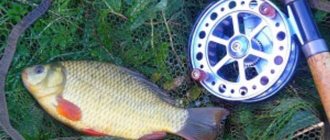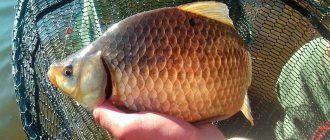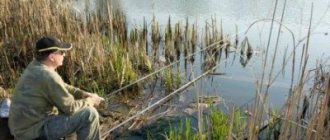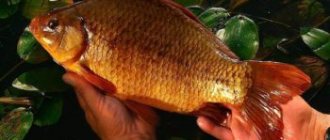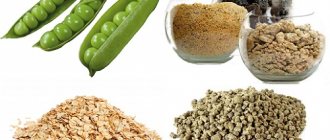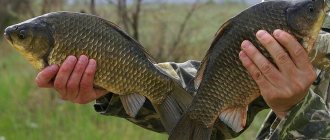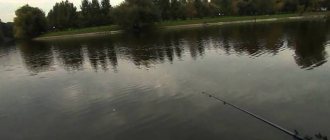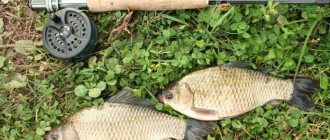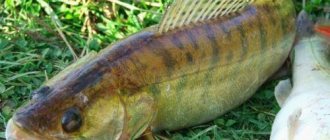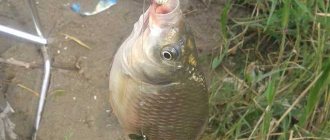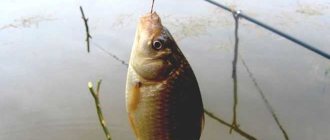A summer large jig for tackle weighs approximately 4 grams. For a spring nod like the one in the image, this is the best option.
A summer fishing rod with a nod will be used for fishing today. How to catch large carp and crucian carp with a fishing rod with a side nod and a jig. The efficiency of fishing with a side nod and jig is much higher than with float equipment. And it’s more pleasant to catch, you don’t sit, stupidly looking at the float, but try in every possible way to outwit, pick up the game with a jig and take the trophy.
For successful fishing you will need the right equipment, which we wrote about in the article “Catching rudd with a jig in winter and summer versions.” When installing equipment elements, pay attention to their parameters, which must meet the requirements for fishing with a side nod.
What does a fishing rod look like with a side nod and a jig?
For successful fishing you will need the right equipment, which we wrote about in the article “Catching rudd with a jig in winter and summer versions.” When installing equipment elements, pay attention to their parameters, which must meet the requirements for fishing with a side nod.
A rig with a reel is more convenient for fishing, especially if you constantly have to let go and reel in the line. On a blind rig, in order to reach the hook, you will have to either constantly fold the telescope or throw the form back, which is not entirely acceptable when wading.
How to cut a nod for a jig with your own hands
Quite often, crucian carp bite very carefully, so you need to use a guard that is quite susceptible to bites. It differs significantly from the winter version, if only because its length is at least 25 centimeters. In this case, the elasticity must be selected quite correctly, in accordance with the mass of the bait.
Rigging a fishing rod with a side nod and a jig is considered the most optimal, since in this form the guard is clearly visible and the bite is difficult to miss, but there are many supporters of its direct placement. Proponents of this option believe that it is easier to hook and remove large fish from the water.
It’s easy to cut a homemade bite indicator from a plastic bottle. They make it somewhat cone-shaped, narrowing from the base to the top. The final tulip is bent from a paper clip and fixed to the nod with thread and waterproof glue. Cambrics are placed at equidistant distances through which the scaffolding will pass.
The second option on how to make a nod for jig fishing is to make it from an unnecessary tape measure. According to the dimensions described above, the workpiece is cut out with metal scissors, then carefully processed with sandpaper to remove burrs and smooth out sharp edges that can cut the line.
A stiffer guard can easily be made from a clock spring. But if you have a carbon blank that has become unusable, you can cut many strips from it, which, after processing with a file, will become excellent bite alarms.
All of these baits can be used and each of them can give good results.
Equipment and everything you need for fishing
There are two options for equipment: blind and sliding.
Blind rig – used if you don’t have guides or a reel on your rod. The supply of fishing line is wound onto a small reel, which is attached closer to the rod's whip. When using blind rigs, your tackle is as light as possible and nothing prevents you from catching fish. Problems can only arise when fishing for large crucian carp, since you have a limited supply of fishing line.
Sliding equipment - used if there is a reel and rings on the rod. The reserve of fishing line on the reel is about 20-30 meters. The reel adds more maneuverability to the gear, both when fishing for large fish, and simply when changing the fishing location.
In general, if there are no bites, you need to experiment with bait:
- corn
- dough
- bloodworm
- pearl barley.
All of these baits can be used and each of them can give good results.
In the summer, the best bait will be insects that the fish feed on in the reservoir of your choice, like caddis flies.
Foam rubber is very often used for fishing. Cut a centimeter narrow strip, putting it on the hook with two punctures. Thus giving different shapes to the nozzle. Foam rubber should be used in a dark color.
You can feed the fishing spots a little to whet the fish’s appetite.
There are many ways to increase your fish catch, but the most effective ones are. Below, the site editors share with you the 3 most effective ways to increase your catch:
- Bite activator. This is a pheromone-based additive that activates receptors in fish. ATTENTION! Rybnadzor wants to ban this bait!
- Any other baits with flavorings are less effective; it is better if they contain pheromones. But the most effective way is to use the new product of 2016 – DYNAMITE EFFECT!
- Learning different fishing techniques. For example, it is written here about spinning wires.
Cloudflare Ray ID: 63a94adbfec01691 • Your IP: 195.64.208.251 • Performance & security by Cloudflare
Cloudflare Ray ID: 63a94adc0bb5fa3c • Your IP: 195.64.208.251 • Performance & security by Cloudflare
The jig can be thrown into any algae-free space and manipulated calmly. This effective bait has proven itself well on wild rivers, where fish need to be caught and for this you have to resort to various tricks.
Before preparing for fishing, the rod is laid out, and the fishing line is wrapped around the blank and passed through the ring on the nod, after which a jig is attached to the end of the fishing line. If fishing is for a predator, then a balancer or a vertical spoon can be tied to the end of the fishing line.
When using a fishing rod with a side nod, you can fish in several ways:
While fishing, you should try out all the existing methods of fishing with a side nod. One of them will certainly give a positive result. Fish are unpredictable and can strike in different ways on different days.
The tackle is adjusted in such a way that the float stands vertically, and the bait is located 5-10 centimeters from the bottom (higher is possible). If you put the bait on the bottom, the likelihood of a snag will increase many times over. Don’t forget to periodically check the bait for the presence and “marketability” of the species: a small thing can chew up a lot, or even completely rip the delicacy off the hook.
Why should you look for crucian carp in the reeds?
Crucian carp is a cautious and timid fish, which is not surprising given so many natural enemies. And if flocks of juveniles can be seen in the free expanses of a reservoir, seasoned individuals prefer to lead a secretive lifestyle, preferring safety to freedom. They can most often be seen in coastal thickets of sedge, reeds, reeds, calamus and other aquatic vegetation. Sometimes while fishing you can notice how the reeds sway in absolute calm - this is a seasoned crucian carp walking around its property and feeding.
Choosing a time to go fishing
You can start hunting for crucian carp from the very early spring, but its activity increases gradually, reaching its climax during the spawning period, which occurs in May in central Russia. Fans of spring fishing should not forget about the prohibitions: active fishing methods and the use of watercraft are prohibited in most reservoirs. That is, you can catch crucian carp in the spring, but only from the shore, with one fishing rod with 1-2 hooks.
In spring, the peak bite begins at 8-10 o’clock and continues until lunchtime, or even evening. At dawn there is nothing to do on the pond - at this time the water is still cold and the fish are not active.
During the summer, the peak of the bite shifts to the early morning, pre-dawn and post-dawn hours. Sometimes crucian carp takes well at night, especially if we are talking about large individuals.
In the fall, the fish also feed actively, but its behavior becomes unpredictable: sometimes it bites en masse, but more often there is no bite even under the most favorable conditions. As the weather gets colder, the period of activity again shifts towards late morning and afternoon. At this time, crucian carp, like all representatives of the carp family, almost completely switches to food of animal origin, storing protein for the winter.
Preparation of equipment
For catching crucian carp specifically from coastal thickets, only a float fishing rod is applicable. When preparing equipment, several factors should be taken into account:
Nozzles and bait
Crucian carp is omnivorous and unpretentious, but with an abundant food supply (and in thickets it cannot be otherwise), it becomes picky. In principle, this fish is most drawn to food of animal origin, so in most cases the use of live baits, in particular, worms and all kinds of larvae (bloodworms, maggots, bark beetles, caddis flies, and so on), is especially effective.
However, the warmer the water, the more crucian carp want something vegetarian. In this case, it makes sense to offer him boiled pearl barley, dough, steamed cereal grains, pasta and even pieces of seaweed. It is wise to equip one hook with plant bait, the other with animal bait.
When preparing bait, you should use water and soil from a local reservoir. As a base, you can use fish feed, flour, crackers, or any porridge. It is necessary to include a small amount of the main bait in the feed mass.
It is recommended to make the bait balls not too dense: there is no flow in the thickets, destruction occurs slowly. For initial feeding, 4-5 balls the size of a fist are enough. When catching crucian carp in the reeds, a primary feeding is usually sufficient: the water flow in the thickets is minimal, the bait does not spread throughout the reservoir. If you really want to, you can toss several walnut-sized balls at intervals of an hour. The main thing is to feed the fish in moderation!
Selection and preparation of a site
It is clear that fishing will be carried out in difficult conditions and will require patience and skill from the angler. If you are lucky, in the coastal thickets you will find a ready-made clearing with a depth of 0.5-1 m. In this case, it is enough to carry out the initial feeding - and after 10-15 minutes you can start fishing directly.
If such luck is absent, you will have to create fishing happiness with your own hands. We put on high wading boots, go into the thickets and make a window ourselves, tearing out sedge and reeds from the silt. Using a shovel will make this work easier. Don’t forget about the path from the shore to the window: it is necessary for effective and maximally safe fishing. Here it is advisable, but not necessary, to pull out aquatic vegetation by the roots, so you can use a knife.
Unfortunately, fishing will have to be postponed for some time: when organizing the space, you will create a lot of noise, which will scare away the crucian carp from the fishing spot. Immediately feed the window area and do other things for a couple of hours, but you can cast the fishing rods right away: there have been cases when the first bite followed within half an hour from the moment the place was cleared.
Features of the fishing process
The tackle is adjusted in such a way that the float stands vertically, and the bait is located 5-10 centimeters from the bottom (higher is possible). If you put the bait on the bottom, the likelihood of a snag will increase many times over. Don’t forget to periodically check the bait for the presence and “marketability” of the species: a small thing can chew up a lot, or even completely rip the delicacy off the hook.
The bite of crucian carp is good: strong and discernible even to an inexperienced eye. As a rule, large fish immediately take the bait, without wasting time on leisurely tasting it. The float sinks, sinks completely, moves sharply to the side, and less often, lays out on the surface of the water.
Hooking must occur immediately, otherwise the crucian carp will go into the thicket along with the equipment. Hook him immediately, but gently, without a sharp jerk. When fishing, lead the fish along the straightest path possible, without allowing it to yaw to the sides. If possible, it is good to lay the fish on its side and slightly raise its head above the water: the crucian carp, having swallowed air, resists much less actively. When bringing prey to the shore or boat, it is possible, and sometimes necessary, to use a landing net.
Fishing for crucian carp from a boat
Using a boat significantly expands the fisherman's capabilities. He has at his disposal not only coastal thickets, but also islands of vegetation far from the shore, where there are often interesting windows. In addition, it becomes possible to approach the thickets from open water.
Another advantage of fishing from a boat is that there is no need for a long rod: you can successfully use a one and a half to two meter stick. The risk of getting caught when casting is significantly reduced, and landing fish is easier. In addition, you can simply swim to the place of the snag, easily pull out the stem with the tangled equipment and untangle it comfortably on board.
The only caveat in this case is the need for maximum silent movement, therefore, even if you have a motor, using it near the fishing spot is strictly not recommended. And the oars should be operated as silently as possible.
Angling tips
As a “dessert” to the main article, let me offer you some practical recommendations from experienced anglers:
Catching crucian carp from coastal reed thickets is a rather labor-intensive task, but if you want to please yourself and your loved ones with enviable trophies, you should not be afraid of difficulties. Moreover, if you follow our recommendations, they are completely surmountable!
Spring. What a long-awaited time for most fishermen, when most of us strive to quickly get out to the nearest body of water. For many at this time, the desired trophy is the so common and ubiquitous crucian carp. When, how and what should you use to catch crucian carp at this time? Let's try to figure it out in more detail.
Catching crucian carp from a boat in the reeds
Fishermen who know first-hand a lot about catching crucian carp characterize this fish from the carp family as unpredictable and sometimes very capricious. However, fishing for crucian carp from a boat
or from the shore in most cases produces excellent results.
It is especially good to catch crucian carp from a boat in the reeds. Why do catching this fish from a boat in the reeds give the best results? It's simple. Crucian carp loves to eat young shoots of reeds; they are a kind of delicacy for him. Experienced fishermen know that fishing for crucian carp in the reeds
will always give the desired results and be interesting. In addition to shoots, a huge variety of small animals find refuge in the reeds, for which crucian carp is a great hunter. An observant angler will always be able to find paths in the reeds along which crucian carp move.
But there are certain difficulties in such fishing. Hooks often get caught in the reeds, which leads to equipment breaks. However, it is quite possible to fish in such rather difficult places by minimizing snags and breaks of hooks and equipment. We will learn further how to do this as safely as possible.
Catching crucian carp from a boat is much more effective than from the shore. After all, using a boat, a fisherman can get to any place he likes, without worrying whether the equipment will reach the right place when casting or not. Such fishing allows the angler to perfectly camouflage himself in the reeds and fish from a minimum distance.
Fishing for crucian carp in the reeds
makes it possible to get real trophies; it is much more difficult to get large crucian carp from the shore, because large crucian carp very rarely come close to the shore, but there are a lot of large crucian carp in the reeds, and there they are less careful than in open water.
Preparing the fishing site in the reeds
While fishing for crucian carp from a boat in the reeds
, you should cast in such a way that the float and part of the equipment with the nozzle are located not next to the reeds, but in the reeds themselves. To throw the tackle into such a place, and reduce the risk of snagging and subsequent breakage of the tackle to a minimum, you should cast into the windows located among the reed thickets. If such windows do not exist, then the fisherman himself can create them. To do this, in the selected area it will be necessary to remove plants to the length and width desired by the fisherman.
In addition, to make casting easier, you can create a convenient passage to the window, and doing this from a boat is much more convenient. And the part of the reeds that is under water will not be damaged. But in the place where the fisherman wants to create a window, the reeds should be pulled out by the roots. In this case, it is recommended to use a rake to avoid cutting your hands on the sharp leaves of the reeds. Or pull it out, after putting on rubberized gloves or mittens on your hands that will protect your hands from cuts.
And to create a passage, only that part of the reeds that is located above the surface of the water is cut off. Typically, pruning shears are used for these purposes. The cut reeds can be put into a watercraft and transported to the shore, and thus not pollute the reservoir. After all, rotting plants will only scare off potential prey with their smell.
But catching crucian carp from a boat in the reeds
, should not occur immediately after cleaning the fishing area. Fishing in this area should be postponed for a couple of days to allow the fish to get used to the change in landscape. However, many anglers claim that even if you start fishing immediately, after preparing a place in the reeds, you can often catch it quite well.
Equipment for fishing for crucian carp in the reeds
Usually fishing for crucian carp in the reeds from a boat
occurs with float tackle. A float rod makes it possible to catch crucian carp in difficult places and at different depths; it is problematic to catch crucian carp in snags or reed thickets with other gear. The rod for fishing in the reeds from a boat should not be too long; on average, rods 2-3 m long are used.
Any rods in our online store
After all, this fish is caught from a boat in rather limited conditions. There should be only one hook in the rig, otherwise the chances of getting caught and breaking the tackle will increase significantly. For fishing in reeds, hooks No. 4.5-6 with a sharp sting are used.
You can use any reel in the rig, but the float for catching crucian carp in the reeds from a boat should have a small mass and be thin, of medium length. A large float, falling to the surface of the water, can scare the fish with its splash. In view of the fact that it is quite difficult to fish out caught prey in reed thickets (there are frequent snags), the base of the tackle must be reliable. Therefore, for the base it is better to use a fishing line with a thickness of 0.20-0.25 mm, and the leads should have a thickness of 0.16 to 0.18 mm.
Catching crucian carp from a boat in the reeds
occurs on a variety of baits. Therefore, an angler must have several options for baits and attachments in his arsenal. Such baits are selected based on the preferences of the crucian carp in a given reservoir and the characteristics of the reservoir itself.
Bait for catching crucian carp
Reed thickets always abound with fish in some reservoirs. There you can catch rudd and roach along with crucian carp, which will make fishing even more interesting and exciting.
Happy fishing!
Equipping a fishing rod with a side nod
Catching crucian carp with a fishing rod equipped with a side nod is considered very successful, because allows you to catch crucian carp in thickets of last year's reeds or in coastal snags. This type of fishing is more mobile than, for example, fishing with the same float rod or bottom gear. At this time, crucian carp does not respond well to bait, so active movement of the fisherman, searching for fish in shallow water overgrown with reeds, is considered a very effective way to catch this fish early.
The photo shows a homemade side nod for equipping a fishing rod. How to make such a nod can be read in the article - “Making a side nod for fishing with a fishing rod using a jig”
It happens that you cannot get to the treasured place - be it a flooded snag or a thicket of dry reeds in a place far from the shore, in this case you should use waders. You can also use a boat, which is even more convenient, but, as you know, to fish with a nod, the angler must get close enough, and since we are fishing in shallow water, crucian carp, especially very large ones, will be afraid of the boat and the shadow falling from it.
It happens that this method of fishing is the only catchable one at a given period of time, when other fishermen, having not caught a single one, or having caught a couple of small crucian carp, only watch with envy from afar the lucky lucky one, whose fish tank is already fairly filled with impressively sized spring crucian carp.
In reed reservoirs, crucian carp bite well on maggots, bloodworms and worms, but also do not refuse plant baits. You need to constantly experiment with attachments.
What gear to choose
You should not fish in aquatic vegetation with a feeder and donka - this is simply impossible due to the short casting distance and its low accuracy. The optimal gear for reed fishing is a regular float rod, but it must also meet certain requirements.
Fishing rod
You need to pick up a short fishing rod (no longer than five meters). At the same time, there should be no thick grass or trees growing on the shore opposite the chosen place, as they will interfere with casting. The best length of a fly rod ranges from 3 to 4.5 meters. Take a lighter fishing rod - this makes it much easier to deliver the tackle to the right place.
See also: How pike winters: 6 features from the life of a predatory fish
Coil
Since it is recommended to choose a fly rod for fishing in the reeds (and its design does not include guide rings and a reel), use a connector - a device that will securely fasten the fishing line to the tip of the rod.
fishing line
It should be no thicker than 0.16 mm. With a larger fishing line diameter, the crucian carp will see the rig and simply won’t approach the bait. Try to choose a fishing line of dark colors, so it will be almost invisible at the bottom of the reservoir.
Float equipment
To make it convenient for you to fish in the reeds, select lightweight floats. The antenna of the tackle should not be very long, because if the floats are long, this can lead to tangling of the fishing line.
Selecting a hook
It is clear that for catching crucian carp it is better to choose small and pointed hooks. Professionals also advise having one leash and one hook on one fishing rod. A larger number of them will again lead to tangling of the equipment. It is better to take a leash thinner than the main line, because if the hook gets caught somewhere, only the leash will break, and not the entire equipment.
Shipment
In the reeds, as a rule, there is no wind, and the depth in such places does not exceed one meter. Therefore, there is no need for a heavy load. Equip your fishing rod with a small sinker. This way you will increase the sensitivity of the gear as a whole and make it invisible to the fish.
If you decide to fish with a fishing rod with a jig, then the same rule applies for choosing a load as for a fly-float tackle. The advantage of gear with a jig is the quick replacement of equipment in case of snags. However, fishing with a nod from the shore is very inconvenient, so it is advisable to use a boat.
See also: Spring herring fishing on the Volga. Simple gear and good choice of location
How to make a window in the reeds for crucian carp
There is no need to go deeper; the window should be made at a depth of 0.5-1.0 m. Reeds grow in shallow water, and crucian carp also live there.
Artificial windows need to be fed and forgotten about fishing for a couple of hours, if in thickets, but if in the mud of a pond, sometimes after half an hour you can already get a bite. But there is a possibility that on the day of “work” there may be no bites at all; the fish needs to get used to the gap that has formed.
You must always remember the variability of the crucian carp bite. Sometimes for weeks it is not possible to catch anything worthwhile until all the conditions for crucian carp bite are met - weather, bait, time, place, season and the luck of the angler.
It has been noticed that in completely covered with mud and overgrown reservoirs, crucian carp take more readily on vegetable baits - pancakes, buns, dough, peas - than on worms.
In reed reservoirs, crucian carp bite well on maggots, bloodworms and worms, but also do not refuse plant baits. You need to constantly experiment with attachments.
Sometimes fishing with a side nod with minimal play of the jig also gives results. When it lies on the bottom for about a minute, and the angler makes only small twitches, causing it to just turn over on the bottom.
How to catch crucian carp in reeds and cattails
Large crucian carp is a cautious fish, but in an overgrown reservoir it feels as safe as at home. In the reeds he boldly takes the bait, unlike in open water. Thickets of reeds, cattails, and reeds are both shelter and food supply. It is known that crucian carp feed on young reeds, as they say “gnaws on the reeds.”
First of all, when you come to such a reservoir, you need to look for accessible clearings and windows in shallow places with a depth of no more than 0.5-1.0 m. You should feed the window and after 10-15 minutes you can start fishing. Having a boat will make the task much easier. The nozzle (bait) is not lowered to the bottom to avoid snagging; the loading is done so that the nozzle floats in the water column. For example, if the depth is 0.5 m, then it is advisable to set the distance from the float to the weight to 0.3 m.
You definitely need to think about how to catch fish. Considering the tightness of the fishing area, you will need a rigid rod with a strong fishing line, since it will not be possible to stand on ceremony, especially with large crucian carp (from 0.5 kg).
You need to fish the crucian carp out of the window immediately, without allowing it to be pulled into the reeds. The bite is standard - the float either sinks, leads, or floats - at this moment you need to make a smooth hook.
Any escape of fish into the grass, or even worse - thickets of reeds, is fraught with a break in the fishing line and the fish disappearing. It is clear that if a two-kilogram crucian carp is hooked, it will be very difficult to get it, and sometimes it is impossible without a boat, especially if the bite occurred at a distance of 5-8 meters from the shore or the angler’s location.
